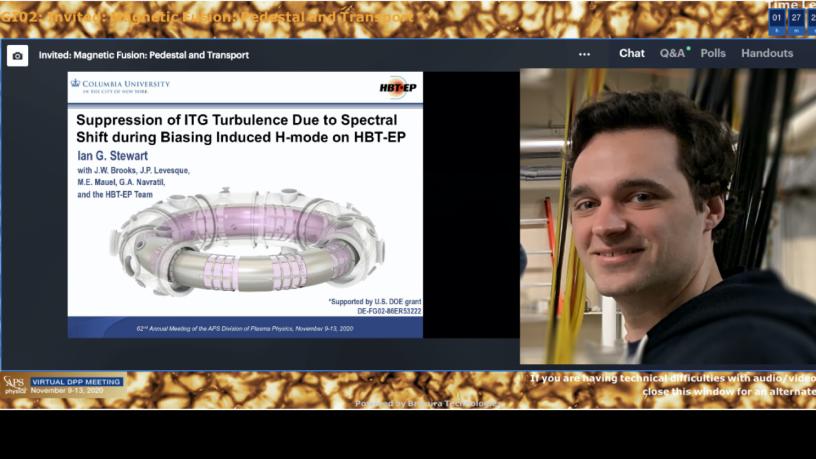Columbia Scientists Present Latest Results at APS Division of Plasma Physics Meeting
This week, Columbia University fusion scientists and students presented their latest results during the 62nd Annual Meeting of the APS Division of Plasma Physics. The APS-DPP Annual Meeting is the largest in the world, with more than 2,200 participants reporting the latest research in all areas of fundamental and applied plasma physics. To ensure the safety of all participants, this year’s Annual Meeting was virtual, with lectures presented and recorded over the internet.
Highlights from this year’s meeting were the invited presentations from Columbia University scientists and students. Applied Physics graduate student, Ian Stewart, described measurements from the HBT-EP Tokamak Experiment at Columbia University and demonstrated how plasma turbulence can be suppressed by carefully driving a thin layer of plasma flow at the plasma edge. Ian’s measured the destruction of turbulent eddies and the reduction of plasma transport and fluctuations that results from plasma flow shear. Columbia University research scientist, Dr. Jeremy Hanson presented new simulations and insights into the control instabilities in the DIII-D Experiment (operated by General Atomics at San Diego, CA). Jeremy showed how improved plasmas modeling leads to more accurate simulations of plasma instability control and presented innovative methods for real-time control that can be applied to upcoming fusion energy experiments using the ITER device. Dr. Francesca Turco presented her analysis of the physics basis to integrate a very high-temperature, high-power fusion reactor core with the much cooled divertor that handles the escaping plasma heat and particles from the plasma. Francesca showed how to optimize the plasma heating and radiation profiles to maintain steady-state stability, good confinement, and adequate radiative power for steady-state reactor operation.
In addition to the three invited presentations of Stewart, Hanson, and Turco, more than 20 other presentations were made by Columbia University students, scientists and faculty from APAM. Presenting their results were graduate students Boting Li, Alex Saperstein, Rian Chandra, and Yumou Wei; scientists Dr. Jack Berkery, Dr. Chris Hansen, Dr. Jeff Levesque, Dr. Jae Kyung Jang, Dr. Young Seok Park, Dr. Jayoung Park, Dr. Yanzheng Jiang, Dr. Steven Sabbagh; and Professors Allen Boozer, Michael Mauel, and Gerald Navratil.
Further information about the invited lectures by Ian Stewart, Dr. Jeremy Hanson, and Dr. Francesca Turco can be found at the links below:
Suppression of ITG Turbulence Due to Spectral Shift During Biasing Induced H-mode on HBT-EP, by Ian Stewart
Non-ideal stability and control of ITER baseline demonstration discharges, by Dr. Jeremy Hanson
The physics basis to integrate an MHD stable, high-power core to a cool divertor for steady-state reactor operation, by Dr. Francesca Turco

Ian Stewart
Applied Physics graduate student Ian Stewart presenting his invited lecture during the online, “virtual” meeting of the APS Division of Plasma Physics.
